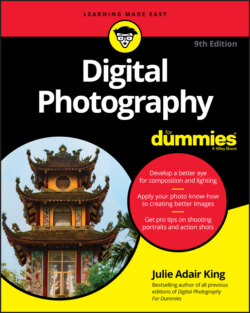Читать книгу Digital Photography For Dummies - King Julie Adair, Julie Adair King - Страница 16
Image sensor size: Full frame or smaller?
ОглавлениеA photograph is formed when light passes through a lens and strikes a light-sensitive recording medium. In a film camera, the film negative performs the light-recording function. In a digital camera, the image sensor handles the task. The sensor is covered with photosites, which are electronic doodads (that's the technical term) that collect the light data needed to create image pixels.
When you look at camera specs, the sensor type and size should be listed. Most cameras now use a type of sensor called CMOS, which stands for complementary metal-oxide semiconductor. I share that nerdy detail just so you won’t spend any more time worrying about what CMOS means. Instead, turn your attention to the sensor size, which is the critical part of the spec.
A smaller sensor generally produces lower image quality than a large sensor. Why? Because when you cram tons of photosites onto a small sensor, you increase the chances of electronic noise that can degrade the picture. So even if two cameras claim the same resolution, the model with the larger sensor is likely to produce higher-quality images than the one with a smaller sensor.
When sensor size is presented as a single number, such as 1″, the number reflects the diagonal measure of the sensor. The photo industry also uses the following terms to refer to certain sizes of sensors:
Full frame: The sensor is the same size as a 35mm film negative (36 x 24mm). Why full frame? The term is related to camera lenses, which are still manufactured using the 35mm film negative as a standard. That means that a full-frame sensor is large enough to capture the entire angle of view that a lens produces on a 35mm film camera. Smaller sensors can capture only a portion of that angle of view. For more on this issue, check out the upcoming section “Lens focal length.”
APS-C (Advanced Photo System-type C): This is a smaller-than-full frame sensor but with the same 3:2 proportions as a 35mm negative. Within this category, the specific dimensions of the sensor vary from camera to camera. Nikon APS-C sensors measure about 24 x 16mm, for example, whereas Canon's typically measure approximately 22 x 15mm. Some people use the term crop sensor to refer to this category because it's a trimmed-down version of a full-frame sensor. Technically, the C in APS-C stands for classic, but crop is more helpful in remembering how these sensors vary from full-frame versions. Also, Nikon coined the term DX to refer to its APS-C sensors, using FX to indicate full-frame sensors.
Micro Four Thirds: These sensors are slightly smaller than APS-C sensors, and as the name implies, they have a 4:3 aspect ratio as opposed to the 3:2 ratio of full-frame and APS-C sensors. Note that the term Four Thirds is used for any sensor that has a 4:3 aspect ratio, even for those much smaller than a Micro Four Thirds sensor.Which is best — 4:3 or 3:2? Well, there's no magic to either aspect ratio. But 3:2 originals translate perfectly to a 4 x 6 print, and a 4:3 image must be cropped to fit. Mind you, you also need to crop 3:2 originals to print them at other frame sizes — 5 x 7, 8 x 10, and so on. And many cameras enable you to choose from several aspect ratios for your pictures or to crop them to a certain proportion using in-camera editing tools.
